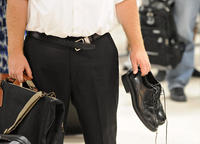-
New mobile app could save lives in earthquakes
A new iPhone app called has been developed to locate loved ones in the world’s earthquake zones during the event of an earthquake; the app, once downloaded, prompts users to enter their own details and those of four friends or family members in order to become their “Buddies”; in the event of an earthquake registering above 5.5, the user’s buddies will instantaneously receive an e-mail displaying a Google map of the user’s location
-
-
Boarding gate with built-in explosives detection speeds up airport security checks

Japanese researchers have developed a boarding gate with built-in explosives detection equipment; the gate collects minute particles which have affixed themselves to IC cards or portable devices used as boarding passes, and can detect within one or two seconds the presence of explosive compounds using internalized equipment; the developers say the gate allows the inspection of 1,200 passengers per hour
-
-
The Western hemisphere’s largest seawater desalination plant to be built in California

The San Diego County Water Authority announced plans to build the Western hemisphere’s largest seawater desalination plant; the plant will produce fifty million gallons of fresh water per day, enough to supply about 7 percent of the San Diego region in 2020
-
-
Law enforcement can store, identify millions of voice samples using new software

Everyone this day can be identified by a fingerprint, DNA, or even a picture. Now, with the help of a Russian company, the FBI will soon be using voice recognition to identify people; the FBI says voice biometrics will be a “reliable and consistent means of identification for use in remote recognition”
-
-
Chile relies on new technologies to cope with frequent earthquakes
Citizens of Chile are used to the ground shaking beneath their feet; in the past two years alone Chile has experienced more than forty earthquakes with magnitudes of six or higher; with so many earthquakes and the potential of thousands dying yearly, Chilean authorities are using new methods to protect their citizens from death and buildings from damage
-
-
Debate over causes of levee failure during Katrina intensifies

A court case in which residents of two sections of New Orleans are suing a construction group has put millions of dollars at stake; residents of the Lower 9th Ward and St. Bernard Parish residents claim that Washington Group International (WGI), an Amy Corps of Engineers contractor, removed several buildings and pilings from land along the Industrial Canal as part of a construction plan to expand the canal’s shipping lock, then failed adequately to plug the holes left behind; the holes allowed rainwater from Hurricane Katrina to seep underneath the 14-foot wall, essentially lifting the wall and allowing the areas to be flooded
-
-
Raytheon Aerostat, SM-6 missile work together to protect ships
As tensions continue to rise over Iran’s nuclear weapons program, and the likelihood of military action to stop Iran from acquiring nuclear weapons increases – military action which would place U.S. ships in the Persian Gulf and the Indian Ocean at risk — there is good news from Raytheon: soon the seas may be a little safer
-
-
Lessons learned: Cheech and Chong at the Y-12 security breach
On 28 July 2012, an 82-year old nun and her two confederates — both senior citizens themselves – breached the vaunted and supposedly impregnable perimeter protection system at the Y-12 National Security Complex at Oak Ridge, where uranium for nuclear weapons is processed and stored (the Y-12 complex is not affiliated with the Oak Ridge National Laboratory [ORNL]); a report on the incident by the Inspector General of the Department of Energy is couched in bureaucratic jargon, but it reveals that the Y-12 security system and practices were much worse than Cheech and Chong could have ever portrayed in their wildest stand-up comedy routines or loopy films
-
-
Boeing to pursue cybersecurity opportunities in Japan
Boeing and Japanese trading company Sojitz are teaming up to offer advanced cybersecurity solutions in Japan to help protect critical government, civil, and commercial information technology infrastructure
-
-
First responders train to deal with a new threat: zombie attack

A company specializing in training military units, federal, and state agencies in security, force protection, emergency response,and disaster management, has a new threat incorporated into its disaster-crisis scenario, which is part of the firm’s annual counterterrorism summit in San Diego: a zombie attack
-
-
More cyber-secure UAVs
The software that runs complex military systems such as UAVs contains tens of thousands of lines of code; this code is designed by human beings, and human beings make mistakes; DARPA wants military systems to be run by fail-safe software, ad for this purpose has created the High-Assurance Cyber Military Systems (HACMS) program; Rockwell Collins has been selected as the prime contractor for the unmanned air vehicle portion of the HACMS
-
-
Verizon’s all-hazard approach to disaster preparation
September is National Preparedness Month in the United States, but Verizon saysits Business Continuity and Emergency Management teams are busy every day of the year monitoring, preparing, and responding to weather-related and man-made events throughout the world; there are 193 member states in the UN, and the company’s BCEM teams are operating in 150 of them and in more than 2,700 cities
-
-
DHS funds more tests of autonomous power buoy for ocean surveillance

Ocean Power Technologies (OPT) has entered into an agreement with DHS Science & Technology Directorate to perform a new round of in-ocean tests on the company’s Autonomous PowerBuoy to demonstrate its use for ocean surveillance
-
-
Cloud OS for the U.S. intelligence community
Cloud management specialist Adaptive Computingis partnering with the investment arm of the CIA, In-Q-Tel, to develop a cloud operating system for use by U.S. intelligence agency
-
-
As shoe-scanning devices fail, passengers continue to remove their shoes

In the last five years the U.S. government has tested several scanning devices for detecting explosives and other weapons concealed in the shoes of airline passengers; after spending millions of dollars on these devices, TSA has concluded that the detection systems are ineffective; the result: removing shoes at security check points is going to be a part of air travel for the foreseeable future
-
- All
- Regional
- Water
- Biometrics
- Borders/Immig
- Business
- Cybersecurity
- Detection
- Disasters
- Government
- Infrastructure
- International
- Public health
- Public Safety
- Communication interoperabillity
- Emergency services
- Emergency medical services
- Fire
- First response
- IEDs
- Law Enforcement
- Law Enforcement Technology
- Military technology
- Nonlethal weapons
- Nuclear weapons
- Personal protection equipment
- Police
- Notification /alert systems
- Situational awareness
- Weapons systems
- Sci-Tech
- Sector Reports
- Surveillance
- Transportation
Advertising & Marketing: advertise@newswirepubs.com
Editorial: editor@newswirepubs.com
General: info@newswirepubs.com
2010-2011 © News Wire Publications, LLC News Wire Publications, LLC
220 Old Country Road | Suite 200 | Mineola | New York | 11501
Permissions and Policies
Editorial: editor@newswirepubs.com
General: info@newswirepubs.com
2010-2011 © News Wire Publications, LLC News Wire Publications, LLC
220 Old Country Road | Suite 200 | Mineola | New York | 11501
Permissions and Policies
